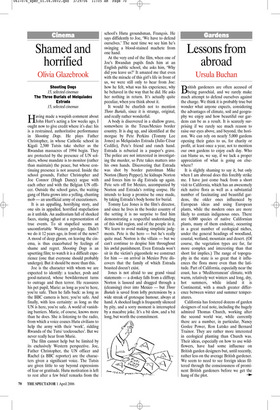Shamed and horrified
Olivia Glazebrook
Shooting Dogs 15, selected cinemas The Three Burials of Melquiades Estrada 15, selected cinemas Having made a waspish comment about John Hurt’s acting a few weeks ago, I ought now to give credit where it’s due: his is a restrained, authoritative performance in Shooting Dogs. He plays Father Christopher, in whose Catholic school in Kigali 2,500 Tutsis take shelter as the Rwandan massacres of 1994 begin. They are protected by the presence of UN soldiers, whose mandate is to monitor (rather than maintain) the peace, but whose continuing presence is not assured. Inside the school grounds, Father Christopher and Joe Connor (Hugh Dancy) argue with each other and with the Belgian UN officer. Outside the school gates, the waiting gang of Hutu grows into a yelling, chanting mob — an unofficial army of executioners.
It is an appalling, horrifying story, and one sits in appalled, horrified stupefaction as it unfolds. An auditorium full of shocked faces, staring aghast at a representation of true events. To sit stupefied seems an uncomfortable Western privilege. Didn’t we do it 12 years ago, in front of the news? A mood of deep gloom, on leaving the cinema, is thus exacerbated by feelings of shame and regret. Shooting Dogs is an upsetting film; to watch it is a difficult experience (one that everyone should probably undergo). But it should be more than this.
Joe is the character with whom we are expected to identify: a teacher, posh and good-natured, whose bewilderment turns to outrage and then terror. He reassures his pet pupil, Marie: as long as you’re here, you’re safe. Then he falls back: as long as the BBC camera is here, you’re safe. And finally, with less certainty: as long as the UN is here, you’re safe. A world of vanishing barriers. Marie, of course, knows more than he does. She is listening to the radio, from which a voice coaxes Hutu civilians to help the army with their ‘work’, ridding Rwanda of the Tutsi ‘cockroaches’. But we never really hear from Marie.
The film cannot help but be limited by its exclusively Western perspective. Joe, Father Christopher, the UN officer and Rachel (a BBC reporter) are the characters given a significant voice. The Tutsis are given little to say beyond expressions of fear or gratitude. Hutu motivation is left to rest after a few brief remarks from the school’s Hutu groundsman, François. He says diffidently to Joe, ‘We have to defend ourselves.’ The next time we see him he’s swinging a blood-stained machete from one hand.
At the very end of the film, when one of Joe’s Rwandan pupils finds him at an English public school, she asks him, ‘Why did you leave us?’ It amazed me that even with the miracle of this girl’s life in front of us, we were still only to hear from Joe: how he felt, what was his experience, why he behaved in the way that he did. He asks her nothing in return. It’s actually quite peculiar, when you think about it.
It would be churlish not to mention Three Burials, since it is strange, original, and really rather wonderful.
A body is discovered in a shallow grave, somewhere in the Texas/Mexico border country. It is dug up, and identified at the morgue by Pete Perkins (Tommy Lee Jones) as Melquiades Estrada (Julio César Cedillo), Pete’s friend and ranch hand. Estrada is reburied in a pauper’s grave. The police are not interested in investigating the murder, so Pete takes matters into his own hands. Discovering that Estrada was shot by border patrolman Mike Norton (Barry Pepper), he kidnaps Norton and forces him to dig Estrada up again. Pete sets off for Mexico, accompanied by Norton and Estrada’s rotting corpse. He intends to keep a promise he once made, by taking Estrada’s body home for burial.
Tommy Lee Jones is the film’s director, and since he lives in the border country of the setting it is no surprise to find him demonstrating a respectful understanding of this wild region, and of the people in it. We learn to avoid making simplistic judgments. Pete is the hero — but he’s really quite mad. Norton is the villain — but we can’t continue to despise him throughout his awful punishment. Even Estrada won’t sit in the victim’s pigeonhole we construct for him — on arrival in Mexico Pete discovers that the family of which Estrada boasted doesn’t exist.
Jones is not afraid to use grand visual statements — a donkey falls from a clifftop; Norton is lassoed and dragged through a (cleansing) river into Mexico — but Three Burials is saved from lofty pretensions by a wide streak of grotesque humour, always at hand. A shocked laugh is frequently silenced by pity, and a sorry moment is interrupted by a macabre joke. It’s a bit slow, and a bit long, but worth the commitment.


























































































 Previous page
Previous page